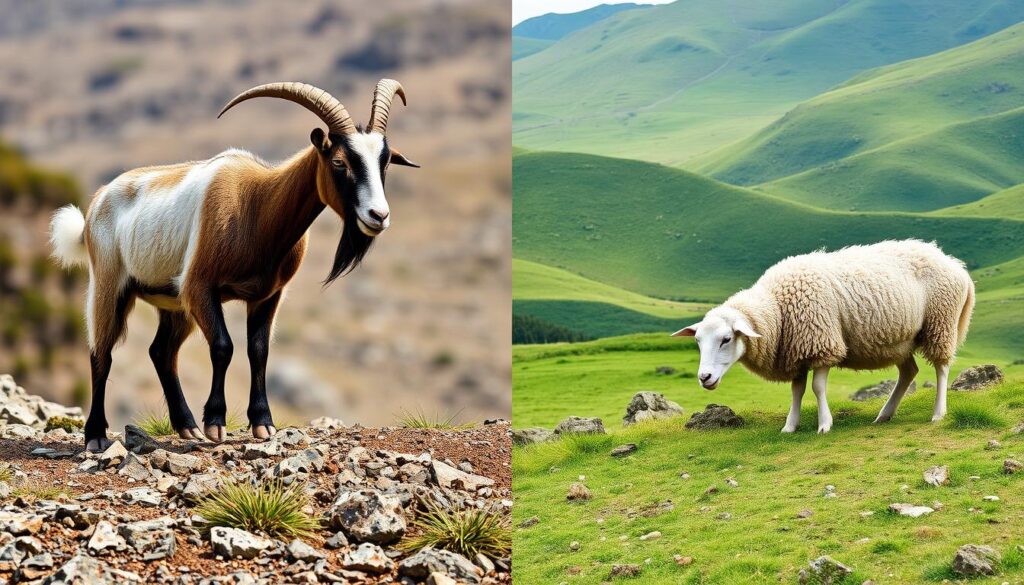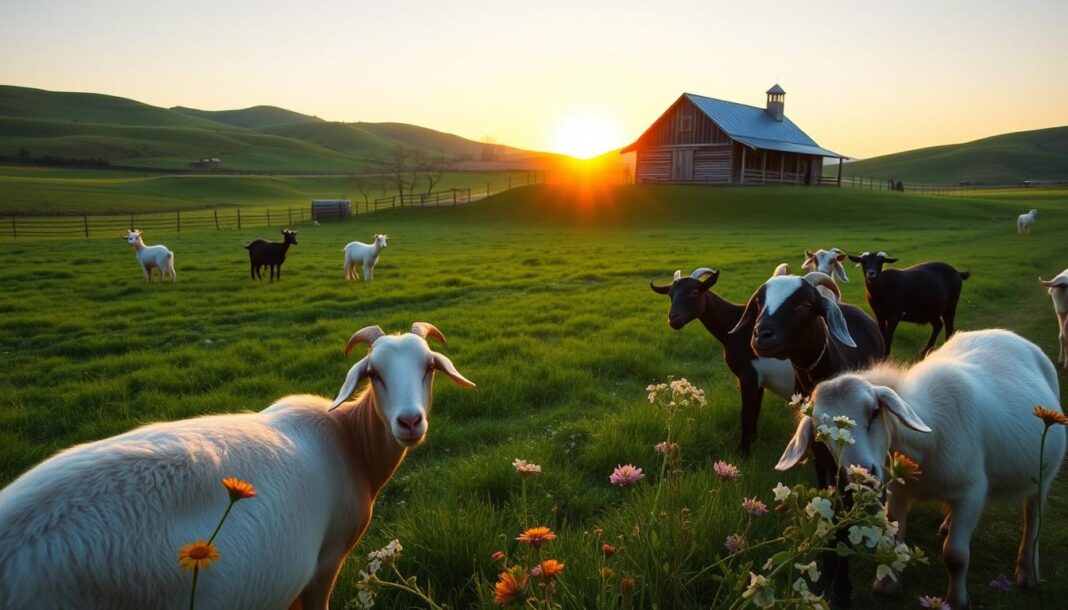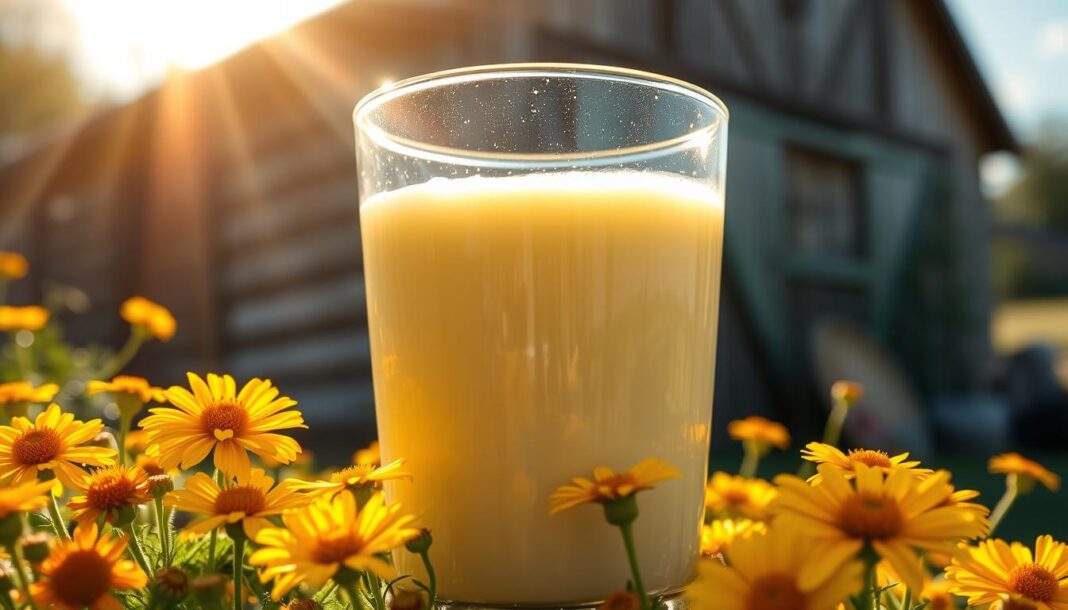Which is Better Goat or Sheep
Did you know goats often sell for more at auctions in the Dallas-Fort Worth area than sheep? This fact shows goats might be a better choice for farming. We’ll look at why goats might be better for you, from meat and fiber to dairy and managing land.
Goats and sheep are both ruminants, but they have different strengths and challenges. Knowing these differences can help you choose the right one for your farm or homestead. This guide will help you decide between goats and sheep based on your needs and resources.
Sahiwal cow breeding best practices can also offer insights into dairy farming. This might be useful if you’re thinking about using goats or sheep for milk.
Introduction
Goats and sheep are both part of the Bovidae family and Caprinae subfamily. Yet, they are different species with unique traits. Goats are in the genus Capra with over 300 breeds. Sheep are in the genus Ovis. Both have been domesticated for thousands of years, giving humans meat, milk, and fiber.
To know the differences, we must look at their definitions. Goats are agile and can live in tough environments. They like to eat shrubs and weeds. On the other hand, sheep are grazers, eating grasses and low vegetation.
The Caprinae subfamily has cloven hooves and horns. But each species has its own special features. Knowing the goat definition and sheep definition helps farmers choose the right one for their needs.
| Characteristic | Goats | Sheep |
|---|---|---|
| Genus | Capra | Ovis |
| Number of Breeds | Over 300 | Hundreds |
| Feeding Habit | Browsers | Grazers |
| Habitat | Rugged, mountainous terrain | Flat, grassy areas |
Knowing the differences between goats and sheep is key. They are both in the Caprinae subfamily of the Bovidae family. This knowledge helps in managing and producing livestock.
Purposes of Raising Goats and Sheep
Goats and sheep are great for farmers and ranchers. They thrive in dry climates and fit well in many places. This makes them popular for livestock purposes in the United States.
Goats are good at eating tough plants, helping clear land. Sheep, on the other hand, are great at eating grass, keeping pastures healthy. Both animals provide meat, with goat meat being leaner and sheep meat (lamb) more common.

Goats and sheep also give valuable fibers. Sheep give wool, and some goats give Cashmere and Mohair. These fibers are used in making clothes. Both animals also give milk, which is used in cooking and medicine.
| Metric | Goat Meat | Lamb Meat |
|---|---|---|
| Calories (per 3 oz cooked) | 143 | 258 |
| Fat (g) | 3.0 | 16.5 |
| Protein (g) | 27.0 | 25.6 |
| Iron (mg) | 3.7 | 2.0 |
| Cholesterol (mg) | 75 | 93 |
Choosing between reasons to raise goats or reasons to raise sheep depends on your farm’s needs. Goats and sheep are both useful for different farming and ranching goals. They add value to various farming systems.
Meat Production
Goat Meat vs. Lamb Meat
Goat meat and lamb meat (sheep meat) are both red meats loved worldwide. But they differ in taste and health benefits. Goat meat is leaner, with more iron and less cholesterol than lamb. It tastes sweeter and has a unique flavor.
Lamb meat, on the other hand, is fattier. This makes it juicier and better for grilling. It has a richer taste.

The nutritional profiles of goat and lamb meat show goat is healthier. It has less fat and more iron. Lamb has more saturated fats and cholesterol.
| Nutrition Comparison | Goat Meat | Lamb Meat |
|---|---|---|
| Iron (per 100g) | 3.8 mg | 1.6 mg |
| Cholesterol | Lower | Higher |
| Saturated Fats | Lower | Higher |
| Potassium | Higher | Lower |
| Sodium | Lower | Higher |
Culinary usage varies between goat and lamb meat. Lamb meat is key in Mediterranean, Middle Eastern, and Indian dishes. Goat meat is important in Caribbean, African, and South Asian cuisines.
Lamb meat is tied to religious festivals in the Middle East and North Africa. Goat meat is a delicacy in Africa and eaten during festivals in India.
Fiber Production

Goats and sheep are both important for their fiber. Sheep wool is famous for making many textiles and clothes. Angora goats give soft mohair, and Cashmere goats have a fine undercoat.
Goat fiber is tough and water-proof. Sheep wool is light and keeps warm. Whether to raise goats or sheep depends on what you want to make and your taste.
| Fiber Type | Key Characteristics | Breed Examples |
|---|---|---|
| Wool | Lightweight, insulating, versatile | Border Leicester, Cotswold, Merino |
| Mohair | Durable, water-resistant, lustrous | Angora Goat |
| Cashmere | Soft, downy, highly prized | Cashmere Goat |
Sheep are the main source of fiber, with over 1,000 breeds. But, Angora and Cashmere goats are also popular for their fibers. The choice between goats and sheep depends on the farmer’s or artist’s needs.
Dairy Production
Goats and sheep both offer milk for making different dairy products. Goat milk is smooth and creamy, making it easier for people to digest than cow milk. It also has more protein and fat.
Sheep milk has even more protein, fat, and solids. This makes it perfect for cheese and yogurt. Sheep’s milk is used to make halloumi, feta, ricotta, and pecorino cheese. It also tastes richer because of its higher fat and protein.

| Dairy Milk Comparison | Goat Milk | Sheep Milk | Cow Milk |
|---|---|---|---|
| Protein Content | Higher than cow milk | Highest among the three | Lower than goat and sheep milk |
| Fat Content | Higher than cow milk | Highest among the three | Lower than goat and sheep milk |
| Digestibility | Easier to digest than cow milk | Easier to digest than cow milk | Harder to digest for some individuals |
| Nutrient Content | Higher in vitamins and minerals | Highest in vitamins and minerals | Lower in certain vitamins and minerals |
Choosing between goat dairy and sheep dairy depends on personal taste and needs. The nutritional and processing differences between the two species are key. Ultimately, the choice between goat milk and sheep milk comes down to personal preference and dietary goals.
Which is Better Goat or Sheep
Choosing between goats and sheep is not straightforward. Each has its own strengths and weaknesses. The right choice depends on the farmer’s or homesteader’s needs and goals.

Goats and sheep differ in how they eat. Goats are natural browsers, eating leaves, twigs, and shrubs. Sheep, on the other hand, prefer short grasses and clover. Goats are better at clearing brush, but sheep are easier to handle and have fewer health problems.
| Comparison Factor | Goats | Sheep |
|---|---|---|
| Domestication | Domesticated around 10,000 years ago | Domesticated around 11,000 years ago |
| Horns | More commonly have horns | More frequently hornless |
| Tail | Erect tail | Hanging downward tail |
| Grazing | Broader dietary preference, can browse on a wide range of plants | Consume short, tender grass of good nutritional quality |
| Social Behavior | More independent, move in smaller family units | Flock together as a social behavior |
| Handling | More challenging to handle, require individual training | Easier to handle, but large rams can be aggressive |
| Wool/Fiber | Short, coarse hair that doesn’t need clipping | Wool coat that requires regular shearing |
| Copper Sensitivity | Less sensitive to copper toxicity | Have a narrower tolerance for excess copper |
In conclusion, the choice between goats or sheep depends on several factors. These include available resources, the purpose of the livestock, and personal preferences. Knowing the unique traits and needs of each animal helps make the right choice for a successful farm or homestead.
Land Management
Goats and sheep have different ways of eating plants. Goats are considered aggressive browsers, eating weeds, shrubs, and woody plants. They can reach high to get these foods. This makes them great at clearing dense areas. Sheep, on the other hand, are grazers, eating grasses and low-growing plants.
For managing dense land, goats are the best choice. Their eating habits help clear thick vegetation. This is useful for land management and weed control. Sheep are better for keeping grasses and low plants in check in established pastures.
Studies have shown goats’ value in land management. At the Swanton Pacific Ranch, 960 goats cleared nearly 55 acres of weeds and invasive plants. This helped create a fire break and reduce wildfire risks. The project was funded by the federal government, highlighting goats’ role in managing vegetation.
Choosing between goats and sheep depends on your land’s needs. Goats are better for clearing brush and managing dense areas. Sheep are more effective in maintaining established pastures. Talking to local experts can help decide the best approach for your land.
Ease of Handling
When it comes to raising livestock, handling ease is key. Goats and sheep differ in manageability, affecting daily tasks for farmers and ranchers.
Sheep are seen as more docile and easier to handle. They tend to stay together, making them simpler to manage. They also rarely test fences or try to escape.
Goats, by contrast, are known for their independent and curious nature. They love to explore and can be hard to keep in one spot. Goats are skilled climbers and may challenge fences, needing extra care to prevent escapes.
For beginners or those with little experience, sheep might be easier. Their calm nature and flock behavior make them simpler to care for. But, for those who enjoy a challenge or find goats entertaining, they might prefer goats.
| Characteristic | Goats | Sheep |
|---|---|---|
| Temperament | Independent, curious, and sometimes mischievous | Docile and prone to flocking behavior |
| Fence Testing | Skilled climbers and more likely to escape | Less likely to challenge fences or intentionally escape |
| Handling Difficulty | More challenging to contain and manage | Simpler to corral and keep in one place |
The ease of handling goats or sheep depends on the farmer’s experience and preferences. Considering these factors can lead to a successful and enjoyable livestock-raising experience.
Economics
When deciding between goats and sheep, economics is key. Goat meat is pricier than lamb, thanks to high demand and limited supply. But, goats might be cheaper to start and maintain, needing less food and forage.
The value of goat and sheep products like meat, milk, and fiber changes with location and demand. Knowing your local market and possible earnings is vital when choosing between goats and sheep.
| Rearing Method | Goat Cost per Annum | Sheep Cost per Annum | Goat Net Return per Animal | Sheep Net Return per Animal |
|---|---|---|---|---|
| Extensive | ₹1,880 | ₹2,060 | ₹1,537 | ₹1,092 |
| Semi-Intensive | ₹2,355 | ₹2,638 | ₹2,174 | ₹2,020 |
| Intensive | ₹3,811 | ₹3,874 | ₹4,186 | ₹3,983 |
The table shows costs and returns for different farming methods. It shows goats might cost more upfront but offer better returns, mainly in intensive systems.
Consider economics, herd health, management, and market demand when choosing livestock. This will help you pick the best option for your farm.
Conclusion
Choosing between raising goats or sheep depends on many things. These include the farm’s purpose, available resources, and personal likes. Both animals have their own benefits and challenges, like meat, dairy, fiber, and land use.
Sheep are famous for their wool, needing shearing every year. Goats, on the other hand, have hair and can eat tough plants. Goats are also more curious and easier to train with positive methods. Sheep, though, are more likely to follow and be less assertive.
By looking at the farm’s needs and the traits of goats and sheep, you can decide better. Whether you want meat, dairy, or fiber, knowing the differences helps. This knowledge helps farmers and homesteaders pick the right animals for their work.




